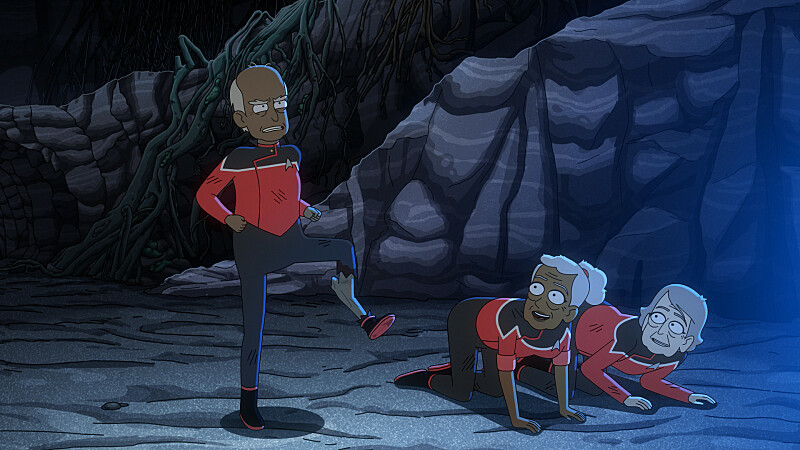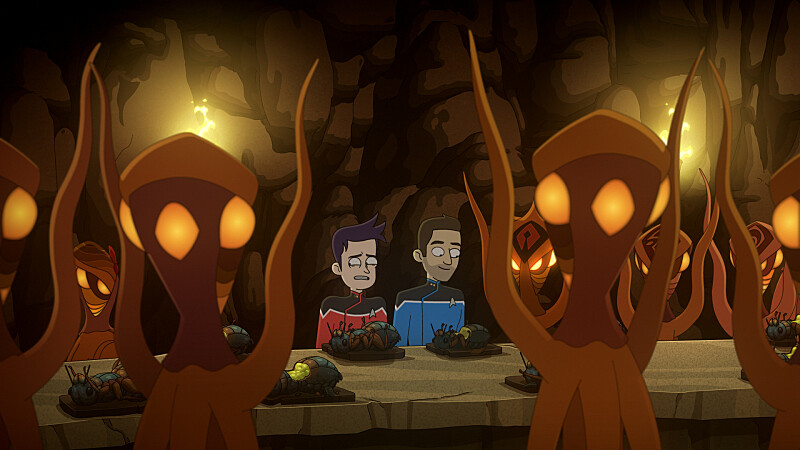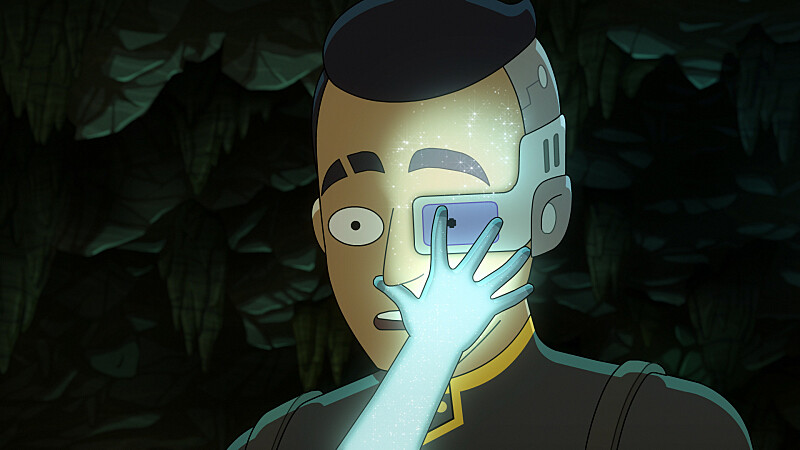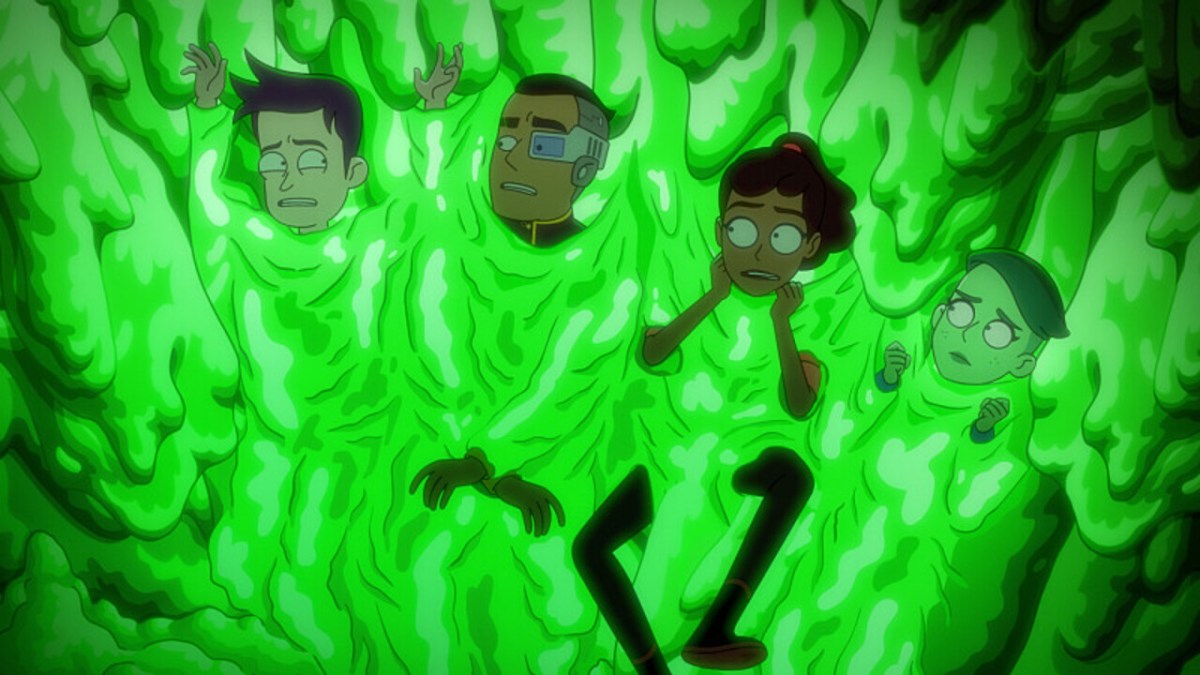Warning: The following review and recap contains spoilers for Star Trek: Lower Decks Season 4, Episode 8, “Caves.”
“Caves” is, unfortunately, another misfire from the fourth season of Star Trek: Lower Decks, following on from “A Few Badgeys More,” also written by Edgar Momplaisir. Like “A Few Badgeys More,” “Caves” has an interesting narrative hook. As the episode’s one-line summary suggests, it is “a classic cave mission.” It is a love letter to a particular genre of classic Star Trek episode. Conceptually, it’s quite clever. Unfortunately, the execution leaves a lot to be desired.
“Caves” is obviously an homage to the classic cave-centric episodes of the Rick Berman era, stories like “Heart of Stone,” “Waltz,” “Demon,” and countless others. These were adventures where the cast and crew would inevitably find themselves wandering around familiar-looking standing cave sets. These caves always had flat floors, gray or reddish lighting, and rocks that looked like they were either sculpted in plastic or made of styrofoam.
Those cave sets are an important part of Star Trek history. Indeed, they outlived any individual show. The first promotional photograph of the cast of Star Trek: The Next Generation was taken on that cave set, before Michael Dorn had been added as a regular. Actor Vaughn Armstrong, a recurring guest star whose association with the franchise spanned from the first season of The Next Generation to the final season of Star Trek: Enterprise, acknowledged that the set had been around for as long as he had.
These sets stood on Paramount Stage 16. “Every week you’d go in there and they’d just miraculously turn half a hectare into a comet or a jungle with a waterfall,” recalled Enterprise regular Dominic Keating. “Planet Hell, we called it affectionately.” However, not all cast members speak about Planet Hell so fondly. Next Generation regular Gates McFadden lamented having to film on “a smoke-filled pretend cave up on Planet Hell,” while Michael Dorn recalls the set was populated by “stray cats.”
In many ways, those cave sets spoke to the limitations of the Berman era. When the production team needed an alien world and didn’t have the time or the budget to shoot on location, they took a trip to “Planet Hell.” These sets were such a fixture that they became a recurring in-joke during the otherwise stoic Berman era. “Parturition” featured an alien world nicknamed “Planet Hell,” while Harry Kim (Garrett Wang) lamented that the caves in “Bride of Chaotica!” looked familiar.
Star Trek writer Ronald D. Moore pointed to those recycled sets as examples of the limitations of the Berman era. “There were things we wanted to do so desperately at Star Trek that we just couldn’t do week after week,” he acknowledged. “We had one big dedicated soundstage, Stage 16, [which] was affectionately known as Planet Hell. Virtually all the alien planets were on Planet Hell and you just got sick of moving the same rocks around and you could only hide the parameters of the soundstage so many different ways.” In some ways, it’s nice that Star Trek has escaped “Planet Hell.”

Of course, given the nostalgic trend in modern pop culture, Stage 16 still holds a special place in the larger context of the Star Trek franchise. The first episode of Star Trek: Discovery shot against green screen on Paramount Stage 16, marking it as a true continuation of Star Trek. There was more overt reference in “Forget Me Not,” which recreated the caves of Trill as depicted in “Equilibrium.” The set was lovingly recreated, emulating the set that Moore had hoped that the franchise could move past.
The idea of Lower Decks constructing a love letter to these familiar cave stories is inherently charming and funny. Part of this stems from the inherent absurdity of it. The live action shows had to use those standing sets to save on budget, but Lower Decks is an animated series. The background animators can draw anything within reason. It takes as much effort to lovingly recreate those cheap cave sets as it does to draw the alien vistas from “Something Borrowed, Something Green.”
The episode isn’t subtle in what it is doing. “I hate caaaaves,” Mariner (Tawny Newsome) complains early in the episode. “Stupid cave mission. I feel like I’ve been in this cave a hundred times.” Boimler (Jack Quaid) concedes, “Hm. Caves do all look the same, don’t they?” Mariner opines, “Nothing good ever comes from a cave mission.” Later, she muses, “It feels like a third of all our missions are in caves.” It’s cute. Many of those cave episodes are awful and boring, and it’s fun to call that out.
While “Caves” is undoubtedly a loving celebration of a classic Star Trek set, it is also a winking homage to a broader category of Star Trek episode tied to that set. It is the late-in-the-season low-budget episode. It is the kind of story that arrives when the production team have gone over budget and over time on other adventures. These episodes are often extremely cliché stories; the stories writers produce when asked to churn out 26 scripts a year.

“Caves” adopts the structure of one of the most notorious examples in Star Trek history, the infamous Next Generation flashback episode “Shades of Gray.” In that episode, utilizing a small cast and a few sets, Riker (Jonathan Frakes) flashes back over events from the previous two seasons. “Caves” operates by similar logic, with the stranded away team using the opportunity to trade stories from their own recent adventures.
Unfortunately, this is where the episode falls apart. The first problem is a lack of commitment to the bit. The idea of doing a flashback episode is a funny reference to the conventions of episodic television, but using it to depict previously unseen events feels like a cheat. For a show as self-aware and self-referential as Lower Decks, there should be a fun way to deliver on the joke. The animated television show Clerks had a wonderful riff on the concept, doing a clip show as the second episode.
The problem is compounded by the fact that the four flashbacks aren’t really any good. Boimler remembers being trapped in a cave with the crew’s conspiracy theorist Steve Levy (Fred Tatasciore). Boimler is frustrated by Levy’s paranoia and lashes out at him. However, Levy is ultimately proven to be entirely correct. Seemingly, Boimler was wrong to dismiss Levy’s insane ramblings. It just doesn’t work as a narrative.
There’s a sense in which this story fits comfortably with the moral outlook of Star Trek: Strange New Worlds, a show that exists in the obvious shadow of the Capitol Riots and Qanon, as evidenced by episodes like “Strange New Worlds” and “Tomorrow and Tomorrow and Tomorrow.” Strange New Worlds has a tendency to respond to political division with a generic shrug and some facile “both-sides-ism.” It’s a real shame to see Lower Decks adopt a similar outlook.
To be fair, “Caves” jokingly shrugs off the moral at the end of Boimler’s story. “Well, Levy, you’re still a crackpot with dangerous beliefs,” Boimler concedes. “But I guess I’ve learned not to… I dunno… yell at you? I don’t know.” Still, it’s framed as a moment of reconciliation and mutual understanding, but one that requires Boimler to abandon his rational evidence-based understanding of the universe to appease a paranoid conspiracy theorist. It’s bad.
The other three stories are just forgettable. Rutherford (Eugene Cordero) recalls getting stuck in a cave with T’Ana (Gillian Vigman), getting pregnant, and giving birth to a baby. This plot thread wasn’t especially funny when Enterprise tried it with “Unexpected,” and it’s no funnier two decades later. Mariner recalls getting stuck in a cave that makes you old, an obvious reference to the plots of episodes like “The Deadly Years,” “Unnatural Selection,” and “Distant Voices.” It’s just not funny.

Perhaps because they share a credited writer, “Caves” shares quite a few structural elements with “A Few Badgeys More.” Most notably, it has a single good joke and spends its runtime running that joke into the ground. In “A Few Badgeys More,” that joke was AGIMUS’ (Jeffrey Combs) ability to turn his light from red to blue to symbolize he was now a “good” computer. In “Caves,” that joke is Tendi’s (Noël Wells) insistence on telling “a turbolift story” — an entirely different genre of Star Trek episode.
More broadly, “Caves” and “A Few Badgeys More” have a generic sort of humanism to them. They are both stories that feel like they are trying to tap into the broad philosophy of Berman era Star Trek about how people are generally nice and will generally get along with one another. Boimler learns to tolerate Levy. T’Ana learns to like Rutherford. Even Mariner extends some empathy to Delta Shift. Of course, there’s no nuance or specificity to any of this. It’s just generic Star–Trek-ness.
Both “Caves” and “A Few Badgeys More” end on effectively the same character and plot beat. In both stories, characters reconcile as outside observers allow them space. In “A Few Badgeys More,” Boimler lets AGIMUS spend time with Peanut Hamper (Kether Donohue) and her family rather than immediately taking him back to the Daystrom Institute. In “Caves,” the Vendorians allow the leading quartet to “enjoy this moment for a little longer” before returning them to the Cerritos.
“Caves” could be a fun episode. There is a lot of fun to be had playing with the conventions of the classic “cave episode” in the same way that “Crisis Point” and “Crisis Point II: Paradoxus” played with the conventions of the film franchise or “A Mathematically Perfect Redemption” riffed on the classic “stranded officer on primitive world” plot. Like “A Few Badgeys More,” “Caves” is a spectacular misfire, and it arrives at the point in the season where Lower Decks normally takes its biggest swings.
It also gets at the weakest aspect of this fourth season. Lower Decks has always had a surprising amount of ambition and imagination and has been willing to go off-format at least once a season. Eight episodes in, the fourth season of Lower Decks has yet to demonstrate that adventurous spirit. Instead, it has just moved some rocks around as it struggles to hide the parameters of its template.






Published: Oct 19, 2023 11:00 am